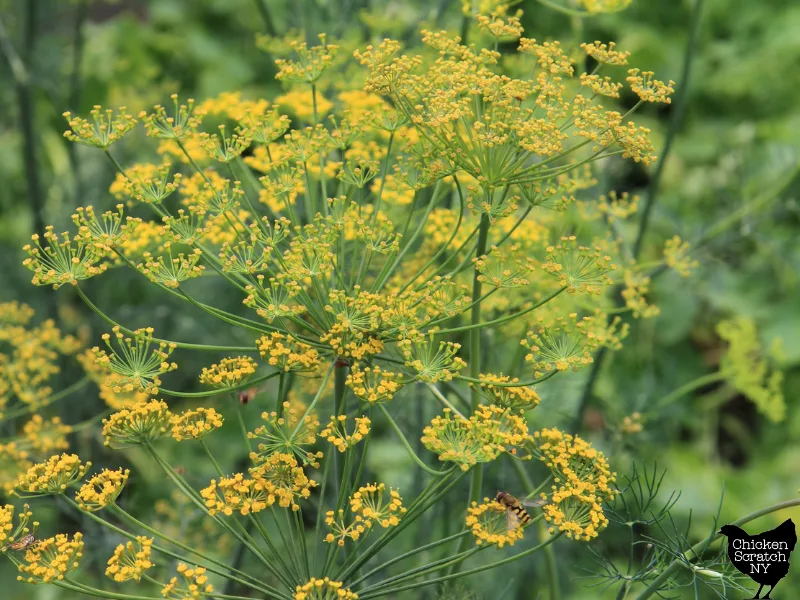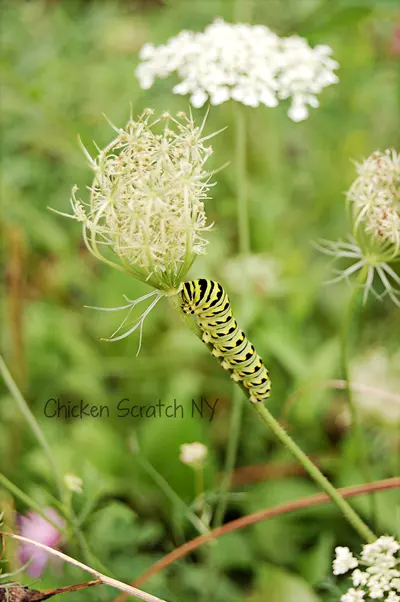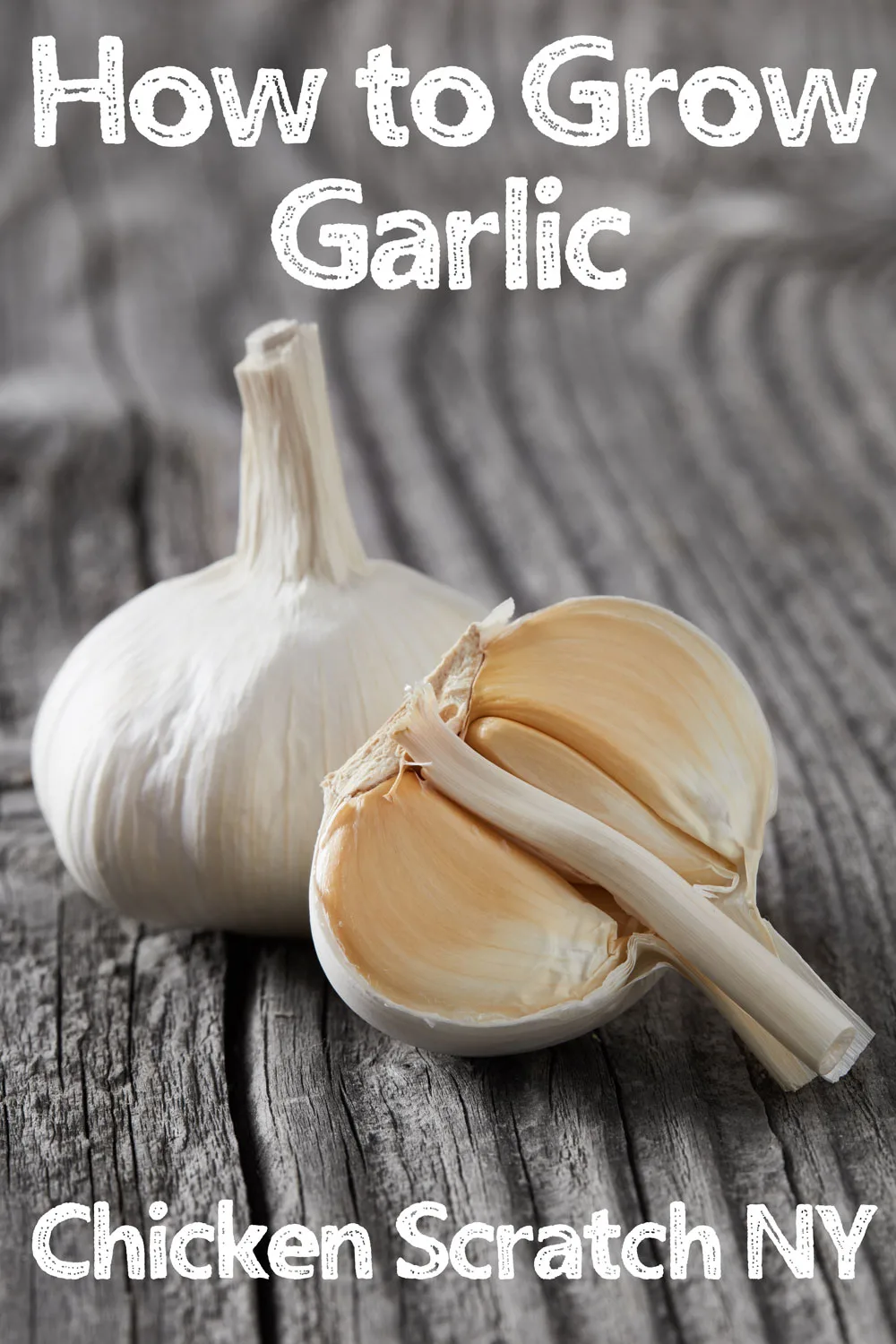Dill plants are a lovely choice for your garden, not only are they amazing in the kitchen, they’ll bring all sorts of butterflies and pollinators to your garden!

If you love pickles, fish or butterflies dill should be on your must-grow list. It doesn’t hurt that it’s unique looking, hands-off and really cheap to grow.
Dill Varieties
Dill belongs to the carrot family along with parsley & celery, and it’s not that hard to see the family resemblance especially when flowering.
The entire plant, from the roots to the stems, leaves, flowers, and seeds is edible and packed with flavor.
There has been quite a bit of specialization when it comes to dill varieties. A lot of newer varieties are slow-bolting, meaning they’re the best choice for dill weed.
Other varieties were bred for giant seed heads that beg to be turned into dill pickles.
Here are a few common varieties of dill:
- Bouquet – grown mostly for foliage, sweeter flavor
- Dukat – mellow flavor
- Fernleaf – slow to bolt, dwarf variety up to 18″ tall
- Tetra – bushy & slow to bolt
- Mammoth – grown mostly for large seed heads, up to 6′ tall
How to Grow Dill
When it comes to planting dill, you don’t have to work that hard! The unfussy plants do best when seeded directly into the garden and aren’t big fans of being transplanted.
In fact, the hardest part of growing dill is keeping it from self-sowing and taking over the entire garden!
Plant your dill seeds into a prepared garden bed (no weeds & relatively smooth soil) by scattering the seeds over the ground, barely cover with soil, press the seeds into the soil and then gently water them.
Dill can be planted all season long, from the time the soil hits 70 degrees up through midsummer in cooler regions.
Established plants can handle temps down to 25 degrees but keep in mind that shorter days equal slower growth when you’re figuring out you cut off for new plantings.
Dill is a great filler option for when you have an empty spot, bare soil is a bad idea, and who wouldn’t want to attract more pollinators to their garden?
The seed can take from 7-21 days to germinate so make sure you keep it moist. It’s pretty easy in the spring but once the summer heat kicks in you’ll have to do a little more babying.

As for spacing, it depends a lot on the final size of the plants so check the packet. Plants that reach 5 or more feet tall will need a bit more space than the smaller varieties.
Once it’s up, dill is a pretty hands-off plant, ready to do its own thing. Adding mulch will cut down on weeding and keep the soil from drying out.
If you add aged compost to the bed before you plant you won’t need to fertilize your dill patch, if it’s looking scraggly you can apply some compost tea or comfrey tea for a bit of a pick-up.
How to Harvest Dill
Similar to lettuce, there isn’t a bad time to harvest dill. You can eat it from the microgreen stage all the way up through using the dried seeds.

If you decide to grow dill for microgreens I recommend doing it indoors in a tray and not out in the garden.
When it comes to picking dill in the garden you can start harvesting leaves as soon at the plant gets to be 6-8 inches tall. My favorite way to do it is to over-plant the seeds and eat the thinnings by clipping them up at the soil line.
That way you aren’t disturbing the roots of the plants that you want to keep growing and the roots will just decompose and turn into fertilizer.
You can also clip off individual leaves with some handy garden snips as you need them in the kitchen. I’m rarely prepared when I go in the garden so I’ll often just pinch them off between my thumbnail and finger.
If you’re nearing the end of the growing season or you need to pull the plants to make soom for something else you can preserve the dill leaves by dehydrating them or by freezing them.
One thing you don’t want to do is just jerk the leaves off unless your intent is to pull up the whole plant.

After a while, your plants will stop growing new leaves and begin to bolt or send up flowers. Exactly when this happens will depend on the variety you’re growing and the weather.
Dill has a tendency to bolt when the temperature gets over 80 degrees. This is another reason to keep planting new dill patches over the growing season.
You can use the bright yellow flowers or let them mature to form seeds. Harvest the dried seeds by clipping off the flower heads into a paper bag or over a bowl to catch the seeds.

By the time they’re dry, the seeds will usually fall right off and you won’t have to do much work to get them separated from the stalks.
Dry dill seeds can be stored in
Cooking with Dill Weed & Dill Seed
I love a good multi-use item and dill hits the nail on the head there. Most herbs are good until they go to seed (ahem, basil) or are only grown for the seeds.

Dill says ‘hold my beer’ and produces edible leaves (aka dill weed), flowers, and seeds. In fact, the entire plant is edible and you can even eat the roots.
Here are a few dill recipes to get you started:

- Caramelized Onion Dill Dip
- Roasted Beets with Dill Dressing from From a Chef’s Kitchen
- Dill Pickle Pasta Salad from Recipes from a Pantry
- Creamy Cucumber Dill Salad from Let’s Dish
- Polish Dill Pickle Soup from An Edible Mosaic
- Dill Pickle Sauerkraut from Homestead Lady
- Grandma’s Dill Pickle Recipe from Lovely Greens
- Small Batch Crunchy Dill Pickles from Simple Seasonal
- Dill Bread from Linger a Little
- Dilly Beans from Grow A Good Life
Growing Dill for Butterflies
If I’m being honest, I intend to make a lot more pickles than I ever make (big thanks to my children eating the cucumbers before they make it into the house) so most of the dill in my garden is grown for the butterflies.

Specifically, Black Tiger Swallowtail butterfly caterpillars. They look a lot like monarch caterpillars with smooth lime green and black skin but they have yellow dots and lack the black antennae.
Their preferred foods are wild queen Ann’s lace, carrot tops, parsley, and dill. They are hungry little buggers and will eat an impossible amount of food before pupating.
Personally, I think the world needs more caterpillars and butterflies so I’m willing to sacrifice my dill. I’d sacrifice my carrots but I’ve never had much luck growing them.

If you’ve struggled in the past with black tiger swallowtail caterpillars decimating your carrot patch planting a mass of dill is a great way to give them a meal without sacrificing your garden.
Carefully transfer the caterpillars from the carrot tops to the dill fronds and wish them well.
Check out my Vegetable Garden page for more ideas or start here:



